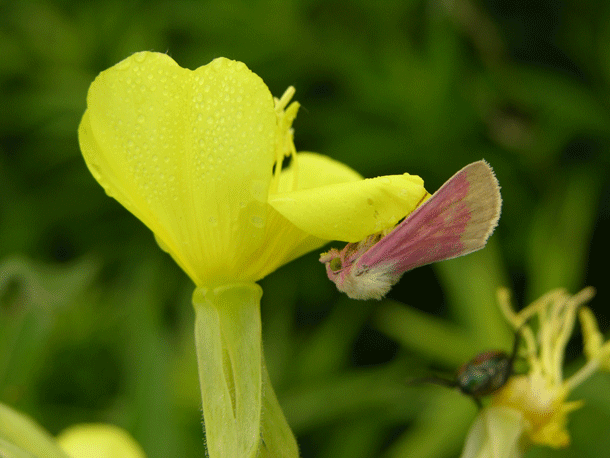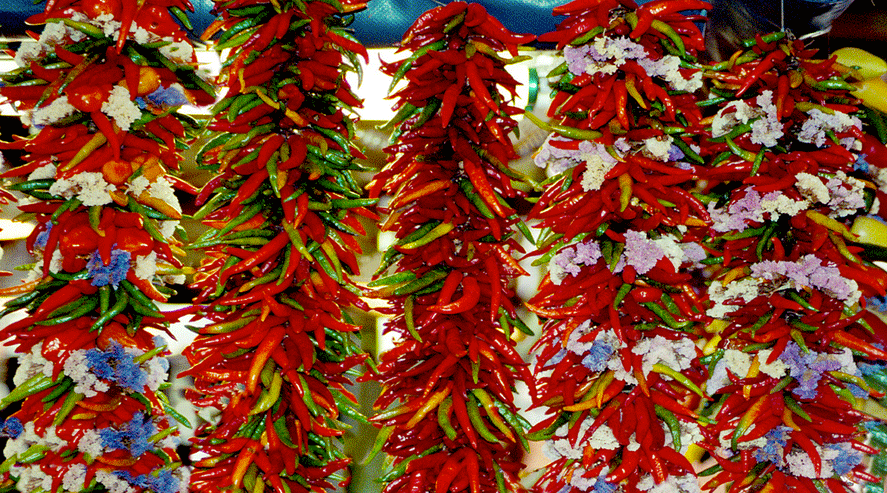How Insects Influence Plant Evolution
Air Date: Week of August 9, 2013

Schinia florida on an evening primrose flower with morning dew. (Photo: Anurag Agrawal)
From the spiciness of the chili pepper to horseradish’s bitter bite, many plant traits are evolutionary adaptations to insect attacks. Cornell biologist Anurag Agrawal explains to host Steve Curwood just how speedily plants can evolve and adapt when insect populations change.
Transcript
CURWOOD: Well - for the silk we use, we depend on the mulberry tree that feeds the silk-worm.
And for millenia, insects - such as the silk worm – have in turn helped guide the evolution and defenses of plants.
A new 5 year study from researchers at Cornell University in Science Magazine focuses on the critical role insects can play in plant evolution, and how speedy that evolution can be.
The lead author is Anurag Agrawal, Professor of Ecology and Evolutionary Biology at Cornell.
AGRAWAL: Essentially plants are the only group of organisms on the planet that can generate their own energy. And something that we don’t often think about is the entire biosphere - all organisms in the food chain - are either directly or indirectly dependent upon plants.
We don’t think of lions as being dependent upon plants, or a particular bird species, but they eat organisms which eat other organisms which fundamentally must rely on plants - eat plants to get their energy. And, because of that, there’s been tremendous natural selection, tremendous pressure on plants over the eons to develop defenses.
CURWOOD: Talk to me about the way that plants have evolved alongside insects.

Horseradish plant (Wikimedia Creative Commons)
AGRAWAL: Yeah, there’s been a long history of circumstantial evidence that many of the traits plants have are adaptations to insect herbivores. If you think about the things we eat, what makes horseradish spicy? Horseradish is spicy because of a series of compounds called glucosinolates that we believe have evolved by natural selection to ward off insects. You know, the poisons that make milkweed so famous? - you know, same expectation. What’s nicotine? Nicotine is a neurotoxin of tobacco that has evolved by natural selection to ward off insects.
CURWOOD: Please describe the specifics of your study for us – what were you looking at?
AGRAWAL: Well, what we did is we set out experimental plots here at Ithaca, New York to examine the impact insect herbivores have on the plants, and removed insects from half of the plots using an insecticide treatment, and over a very quick period of time – about five years, five generations of the plants we were studying, the common Evening Primrose, it’s a wildflower – removal of insects resulted in the evolution of two very critical plant traits: How early the plants flower and the production of a toxin in the fruits of those flowers. When we removed insects, the plants were able to relax those defenses. They flowered earlier and they produced less of those toxins in their fruits.

Hot peppers drying in a market. (Photo: Donna Sutton)
CURWOOD: So how surprised were you by these results?
AGRAWAL: The results that we got we had anticipated, and it was sort of part of our hypothesis, but what really surprised us was the rapidity of this evolutionary response. Seeing this response in five years was dramatic and it sort of – you know, it really knocked our socks off in the sense that, we know that evolution can be rapid, but to watch it happen, watch the genetic change happen over that period of time, was something that surprised us and the rest of the scientific community.
CURWOOD: I mean, one thinks of evolution, one thinks that it takes a long time for example, say to get from the great apes to humans - like millions of years, right?
AGRAWAL: Yeah, and that’s right. Evolutionary biology, in a sense is a historical science. We’re trying to piece together, often, how we got to where we are now, by looking into the past. And you’re certainly right that most speciation events – that is when one ancestor gives rise to two new entities that are isolated reproductively –often does take thousands to millions of years.
In our study, what we’re talking about is the rapid adaption that occurs within a species, and the way one might think about how this might be operative in nature is as the climate changes, as we have a set of good or bad years, if in a particular location there are high pest loads compared to another place where there are low pest loads, we can expect to see rapid change in those populations.
If those environmental effects are sustained over hundreds or thousands of years, we might then expect a new species to be born.
CURWOOD: So, seeing such rapid evolution in plants, what do you see as the larger significance of these findings?
AGRAWAL: I think there are a few things that are significant. One is the recognition that evolution occurs all around us. I think that’s an important message for the American public, in the sense that there’s surprising to me and many scientists still some debate about the importance of evolution in the history of the planet and the history of the organisms that we have on the planet. So, the fact that we can in real time, see that change in genes and genotype frequencies in that short period of time is a critical message to the public.
From a biological, and more academic perspective, one of the things we reported, one of the things that I think was known to Darwin, and that he sort of speculated on but still hasn’t cemented itself as dogma among scientists, and that is that – on the same time scale that ecological interactions occur, in our study for example, as the environment changed, - competition between species, plants that were in our plots, was intensified. On that same time scale, there were evolutionary changes that were occurring. And so I think one of the main messages to the academic community is: ecology or environmental change, and evolution, can occur on the same time scale and may in fact feed back with one another.
CURWOOD: I must ask what are the implications of your study and how we think about insecticides?
AGRAWAL: Well, it’s complicated, and I appreciate the question. Insecticides certainly have been a very valuable tool in the production of agricultural crops, and I think that what it tells us is that when we take insects out of the picture – using things like insecticides – we are encouraging plants throughout the evolutionary process to relax their defenses.
And, in fact, this is a story that I think is unfortunately really a big part of worldwide agriculture, and that is that we tend to select varieties of plants to grow that are diminished in their natural defensive capacities. If you take a wild plant that has survived out there for millions of years, it typically has a remarkable array of toxins and defense tactics to ward off pests.
About 10 percent of all plants produce hydrogen cyanide. We know hydrogen cyanide as a very general toxin – an anti-life compound – and it’s hydrogen cyanide that’s in 10 percent of the plants. It has no primary function, it doesn’t help the plant capture sunlight or produce seeds directly, what hydrogen cyanide does is it poisons insects that are trying to eat those plants.
One of the things that I think we do a little too well is we – either on purpose or inadvertently – we breed crops so that they have relaxed defenses and that increases our needs and our usage of pesticides, which I think we can all agree is problematic for the environment.
CURWOOD: Anurag Agrawal is Professor of Ecology and Evolutionary Biology at Cornell University. Thanks so much for taking the time today!
AGRAWAL: Thank you!
Links
Abstract of paper on insect-driven evolution in Science Magazine
Living on Earth wants to hear from you!
Living on Earth
62 Calef Highway, Suite 212
Lee, NH 03861
Telephone: 617-287-4121
E-mail: comments@loe.org
Newsletter [Click here]
Donate to Living on Earth!
Living on Earth is an independent media program and relies entirely on contributions from listeners and institutions supporting public service. Please donate now to preserve an independent environmental voice.
NewsletterLiving on Earth offers a weekly delivery of the show's rundown to your mailbox. Sign up for our newsletter today!
 Sailors For The Sea: Be the change you want to sea.
Sailors For The Sea: Be the change you want to sea.
 The Grantham Foundation for the Protection of the Environment: Committed to protecting and improving the health of the global environment.
The Grantham Foundation for the Protection of the Environment: Committed to protecting and improving the health of the global environment.
 Contribute to Living on Earth and receive, as our gift to you, an archival print of one of Mark Seth Lender's extraordinary wildlife photographs. Follow the link to see Mark's current collection of photographs.
Contribute to Living on Earth and receive, as our gift to you, an archival print of one of Mark Seth Lender's extraordinary wildlife photographs. Follow the link to see Mark's current collection of photographs.
 Buy a signed copy of Mark Seth Lender's book Smeagull the Seagull & support Living on Earth
Buy a signed copy of Mark Seth Lender's book Smeagull the Seagull & support Living on Earth

